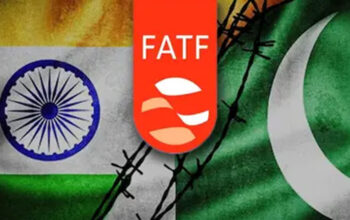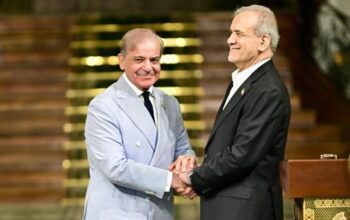By Staff Reporter
ISLAMABAD: Pakistan’s economy is set to expand 2.7% in the fiscal year ending June 2025, up from 2.5% last year, though concerns over inflated industrial figures and a weak agricultural sector cloud the outlook, the government’s economic survey showed on Monday.
The survey, unveiled by Finance Minister Muhammad Aurangzeb a day before the federal budget, paints a picture of cautious optimism amid global headwinds and domestic challenges.
Aurangzeb positioned the gain against a global slowdown, with world GDP growth projected to dip to 2.8% in 2025 from 3.5% two years ago. “Our recovery aligns with global trends,” he said, emphasising the need for stability over fleeting gains.
The 2.7% growth forecast falls short of Pakistan’s long-term average of 4.7% and the government’s initial target of 3.6%, reflecting a tempered recovery. It aligns closely with revised estimates from the International Monetary Fund (IMF) and World Bank, which pegged growth at 2.6% and 2.8%, respectively, in April 2025.
The industrial sector’s provisional growth of 4.77%, the strongest in four years, stands in sharp contrast to a 1% contraction over the first nine months of FY25. “This number will be revised down, especially due to enlarged growth numbers of the industrial segment at 4.77% compared to actual growth in 9MFY25 at -1%,” said analyst Mohammad Sohail at brokerage Topline Securities.
Electricity, gas, and water supply surged by 28.88%, with construction and manufacturing up by 6.61% and 1.34%, respectively. Yet, declines in mining and quarrying (-3.38%) and large-scale manufacturing (-1.53%) underscore uneven performance. The survey flagged underperforming sectors like chemicals, iron, and steel for closer scrutiny, while citing gains in autos (40%), wearable apparel (8%), textiles (2%), and petroleum products (4.5%).
The services sector, a backbone of the economy, grew by 2.91% in FY25, up from 2.19% the previous year. Public administration and social security led with a 9.92% rise, though wholesale and retail trade eked out just 0.14%. With 9MFY25 growth averaging 2.97%, analyst Sohail hints at potential upward revisions. Information and communications expanded by 6.5%, and construction and real estate rose by 3.8%, bolstered by a 4.1% uptick in food services and higher transport activity.
Agriculture, however, posted a dismal 0.56% growth, the lowest in nine years, compared to a five-year average of 3.38%. A 13.5% drop in key crops and a 19% decline in cotton ginning dragged the sector down, despite gains in other crops (4.78%), livestock (4.72%), forestry (3.03%), and fishing (1.2%).
“This is a gradual recovery and the right way to go about it is to focus on sustainable growth,” the minister said. “The last thing we want is to go through another round of boom and bust cycles.”
Inflation has emerged as a bright spot, with the Consumer Price Index (CPI) plummeting from over 29% in 2023 to 4.6% currently, outpacing global trends estimated at 4.3% for 2025. “Inflation has been a fantastic story for Pakistan,” Aurangzeb said, crediting coordinated fiscal and monetary measures.
The State Bank of Pakistan slashed its key policy rate from a peak of 22% in 2023 to 11%, easing debt servicing costs by Rs800 billion. “So, I think we’ve moved in the right direction in terms of the global figures,” Aurangzeb added.
Fiscal discipline has yielded gains, with the public debt-to-GDP ratio dropping from 68% to 65% and the fiscal deficit narrowing to 2.6% of GDP. The primary balance posted a 3% GDP surplus, a sign of tightening belts.
Aurangzeb highlighted a shift in debt strategy, reducing short-term borrowing and extending local debt maturities by 66%. “We reduced the prices and money going into markups,” he said, signaling a move away from desperate borrowing. Credit to the private sector surged, with Rs681 billion in loans disbursed from July 2024 to May 2025, as banks pivot toward Islamic financing.
The minister said the government structural reforms picking up pace, with 24 state-owned enterprises slated for privatization. “SOEs have been talked about at length, and Rs800 billion has been spent. If you add up equities and guarantees, this goes into trillions. Those trillions are better spent elsewhere,” Aurangzeb said.
He highlighted the pivotal role of the International Monetary Fund (IMF) in restoring fiscal stability. “Our credibility and trust was re-established under Prime Minister Shehbaz Sharif’s leadership,” he said, adding that Sharif had signed the Stand-by Arrangement (SBA) with the IMF before the caretaker government took charge. “We’re rewriting the economy’s DNA,” Aurangzeb said, calling such reforms long overdue.
Pension reforms will introduce defined contributions for new hires from July 2024, while rightsizing efforts aim to trim 43 ministries and 400 attached departments. “It’s not [about] the what and why the federal government has to be rightsized. The question is how.”
The external position has strengthened markedly, with the current account swinging from a $1.3 billion deficit to a $1.9 billion surplus between July 2024 and April 2025. Remittances soared 30.9% to a projected $37-38 billion for FY25, up from $10 billion two years ago, hitting a record $4.1 billion in March. “Remittances, like inflation, have been an outstanding story,” Aurangzeb said. The Roshan Digital Account initiative crossed $10 billion in inflows, with 814,000 accounts opened. Exports rose 7%, led by IT and a $400 million freelance haul, while imports climbed 12%, with machinery (16.5%) and transport (24%) supporting agriculture.
“Forex reserves as of June 30, 2024, were $9.4bn, which was a huge and remarkable recovery from where we were back in 2023, where we were down to two weeks of import cover. The recovery after [June] 30 continued and we consolidated it in 2024-25.”
On fiscal performance, Aurangzeb said the tax-to-GDP has hit a five-year high . he transformation hinges on “people, processes, and technology,” with innovations like “digital invoicing, production tracking, AI audits, faceless customs regime” driving progress. Revenue collection jumped 26% year-on-year, following a 30% rise last fiscal year. “There has been a deepening and expanding of the tax base,” he added, noting individual filers doubled to 3.7 million and high-value filers surged 178%.
“Any transformation takes two to three years, and I think we have done a good job in terms of where we wanted to take things,” the minister said, pointing to “remarkable” recoveries in the power sector as a key win.
Energy reforms featured prominently, with industrial and household tariffs slashed and private sector-led boards introduced for power distribution companies. “Distribution losses will be reduced going forward,” Aurangzeb said, citing the National Transmission and Despatch Company (NTDC) distributing to three firms as a step to ease transmission bottlenecks.
Copyright © 2021 Independent Pakistan | All rights reserved




